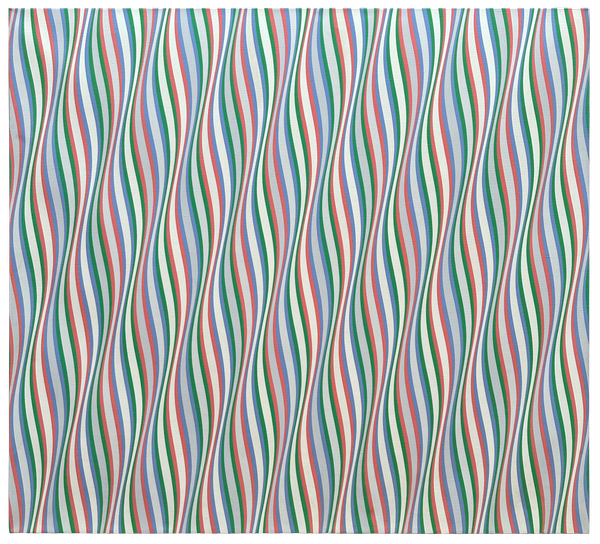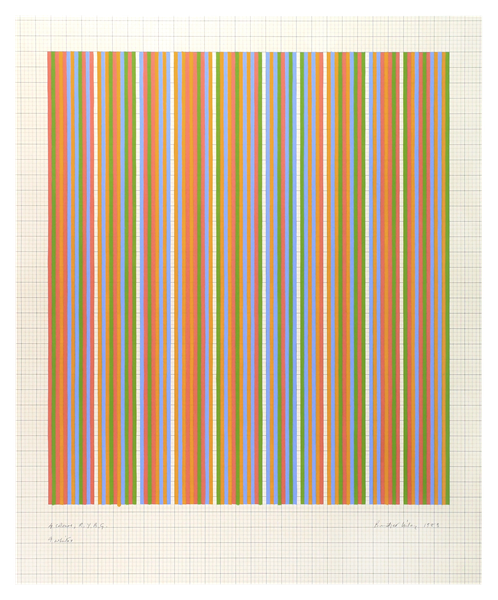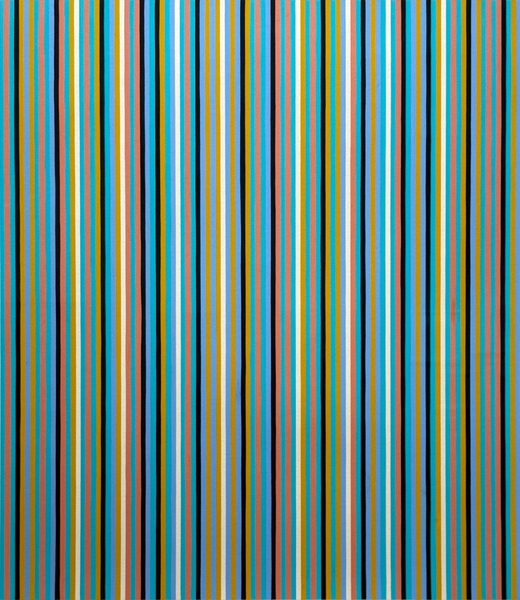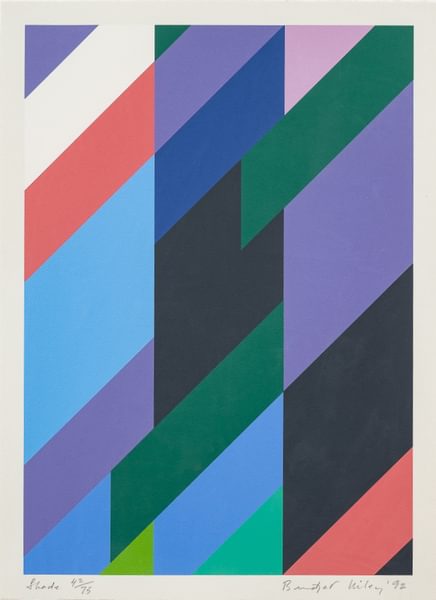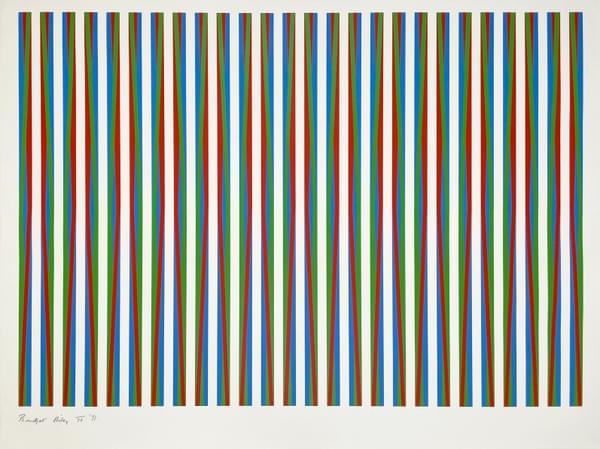Untitled
"Riley's work from the mid-1970s until the end of the decade took her concern with colour interaction and its relationship with light to new levels of complexity. The vehicle for these developments was her adoption in 1974 of the curve form as the fundamental unit of her paintings."
Paul Moorhouse, 'A Dialogue with Sensation: The Art of Bridget Riley' in Exhibition Catalogue, London, Tate, Bridget Riley, 2003, p. 20
"I saw that the basis of colour is its instability. Instead of searching for a firm foundation, I realised that I had one in the very opposite. That was solid ground again, so to speak, and by accepting this paradox I could begin to work with the fleeting, the elusive, with those things which disappear when you actually apply your attention hard and fast."
The artist interviewed by Michael Craig-Martin in: Robert Kudielka, Ed., Dialogues on Art, London 1995, p. 56
Bridget Riley's mesmerising 1974 untitled canvas harnesses all the lessons of her previous output and achieves incredible optical, chromatic and spatial effects through her sophisticated manipulation of line, colour and form. This series of work establishes the curve as an organising principle and exposes the potential volatility in our perception of colour. Previously Riley had mostly used either straight lines of repeated colours or curved lines in wider spectrums of changing colour. However, while the linear pattern of the present work fundamentally destabilises the picture plane, the simple pale red, blue and green lines create the sensation of other colours such as orange and pink. We are presented not only with the paradox that is inherent to all Riley's most accomplished works - how can such seemingly simple pictorial means generate such magisterial and diverse effects – but also with a more intangible atmospheric quality that seems to loom out of the canvas towards us.
In 1974 Riley visited Switzerland and purchased a quantity of acrylic paint by the manufacturer Lascaux, of whom she had heard great things. The present work is created with this medium, which is stated in Riley's typical signature bold lettering on the stretcher on the reverse. Uncertain how the paint would age, the work was sold by Rowan Gallery to a distinguished private collector, the intention being to revisit the painting in time to see if the acrylic was as reliable as her customary oil medium. It was, however, forgotten about and was shown to the artist for the first time since, some two years ago by the family who had purchased the work in 1974. Needless to say, the work is in remarkable condition and its rediscovery was greeted by the artist with delight.
Encountered at a typical viewing distance the scale of the painting fills our field of view while the symmetry of the near-square canvas provides a deeply satisfying sense of geometric order. We are immersed in the cascading movement of a powerful vertiginous visual effect. Indeed the elegance of the picture's format contrasts perfectly with the sensation of flux and movement which pushes and pulls the boundaries of the canvas edge. The sets of colour lines within the composition run across the canvas in vertical waves and, while the height of each curved line expands and contracts several times across the picture plane, the shape of each pair of lines is identical. Creating the impression of alternating fast and slow movement, the painting offers contrasting states of tension and release and these competing forces manifest what Riley dubbed 'Virtual Movement'.
With these paintings Riley also changes the viewer's perception by manipulating the topographical arrangement of colour, an effect that is most noticeable in the case of the reds. Where a red line is backed against a blue line it appears much closer to pink and where one is backed against a green line it seems almost orange. The success of this effect is compounded by the complex sequence of colours: although two red lines quasi-alternately face each other across a band of white or muted grey, they are backed variously by either blue or green in a protracted order. However, the high frequency of the repeated lines also amplifies the effect and when we scrutinise individual areas we lose focus. Through these techniques Riley effectively reclassifies colour as a transient and evolutionary phenomenon as opposed to a fixed point of reference.
This series of work summates over twenty years of Bridget Riley's sincere interest in the possibilities of colour. In the 1950s she made studies from the Pointillism of Georges Seurat, who was influenced by the empiricism of Charles Henry and his theory that mathematical formulation could directly explain aesthetic results. Riley was also fascinated with the manipulation of colour by Abstract Expressionists, in particular Jackson Pollock whose work she visited both at Tate's Modern Art in the United States in 1956 and at the Whitechapel Gallery in 1958. Although her precise and graphic visual dialect is somewhat opposed to Pollock's improvised Action Painting, she was attracted to the multi-focal surfaces of his paintings which so revolutionised the single-focus perspective of the European tradition. Her interest in 'Virtual Movement' was, of course, also indebted to the rhythmic visual language of the Italian Futurists that she had seen at the XXX Venice Biennale in 1960.
Riley's early colour experimentations never left her studio while breakthrough works such as Blaze 1 of 1962 used binary black and white to set up optical illusions. Colour first appeared in the form of temperate greys in 1965 with Arrest 2 before it became a central protagonist in 1967 with her masterpieces Cataract 3, Chant 2 and Late Morning. Riley subsequently experimented with colour in various different compositions and, recognising that chromatic visual effect is heightened by the length of the edge between two colours, started to marry colour with the soft reiteration of a contracting and expanding curve. Thus Untitled stands at the height of this investigative arc and embodies Riley's exploration of what line, colour, and form could achieve.
Despite the faultless fabrication of the calculated and diagrammatic composition, the sense of swelling and contracting movement, rolling waves and flickering adjustments in hue is more evocative of phenomena found in nature, such as shifting patterns of clouds or the intangible play of light on rippled water. Indeed, by deconstructing the chromatic character of light, Riley's stunning painting creates an atmospheric space in front of the canvas, bringing the area for dramatic confrontation between the viewer and the canvas in front of the picture plane. This is reminiscent of the vast paintings by Pollock and other Abstract Expressionists, whose all-over gestural painting resulted not only in optical, chromatic and spatial effects, but also a more immediate and emotional sensory experience. By destabilising compositional architecture and fundamentally disorganising colour, the oscillating and evolving character of Untitled imbues the beholder with pure energy. Riley's destabilisation of the image can be viewed as one of the most radical departures in the history of Post-War British Art, and with paintings such as the present work her art even surpasses mere visual experience.
Untitled
- Artist
- Bridget Riley (b. 1931)
- Title
- Untitled
- Medium
- Lascaux acrylic on linen
- Date
- 1974
- Size
- 57 x 62 ¾ in : 144.8 x 159.4 cm
- Inscriptions
- Signed and dated on the overlap
Signed, dated and inscribed with the medium and sizes both on the reverse and the stretcher - Provenance
- Rowan Gallery, London, 1974
Private collection, England, acquired directly from the above and thence by descent
Private collection, England - Literature
- This work will be included in the forthcoming revision of the catalogue raisonné of Bridget Riley paintings
- Registration
- This work is recorded in the archives of the Bridget Riley Studio under reference P7408 and will be allocated a BR number in due course
- Reference
- AC23-46
- Status
- Private Collection
- Status
- Currently Unavailable
Available Artists
- Albers Anni
- Ancart Harold
- Andre Carl
- Avery Milton
- Baldessari John
- Barnes Ernie
- Calder Alexander
- Castellani Enrico
- Clough Prunella
- Crawford Brett
- Dadamaino
- de Tollenaere Saskia
- Dyson Julian
- Elsner Slawomir
- Freud Lucian
- Gadsby Eric
- Gander Ryan
- Guston Philip
- Haring Keith
- Hartung Hans
- Hayes David
- Held Al
- Hepworth Barbara
- Hill Anthony
- Hitchens Ivon
- Hockney David
- Hutchinson Norman Douglas
- Jenney Neil
- Katz Alex
- Kentridge William
- Knifer Julije
- Kusama Yayoi
- Le Parc Julio
- Leciejewski Edgar
- Léger Fernand
- Levine Chris
- Marchéllo
- Martin Kenneth
- Mavignier Almir da Silva
- Miller Harland
- Mitchell Joan
- Modé João
- Moore Henry
- Morellet François
- Nadelman Elie
- Nara Yoshitomo
- Nesbitt Lowell Blair
- Nicholson Ben
- O'Donoghue Hughie
- Pasmore Victor
- Perry Grayson
- Picasso Pablo
- Pickstone Sarah
- Prehistoric Objects
- Riley Bridget
- Ruscha Ed
- Sedgley Peter
- Serra Richard
- Shrigley David
- Smith Anj
- Smith Richard
- Soto Jesús Rafael
- Soulages Pierre
- Spencer Stanley
- Taller Popular de Serigrafía
- The Connor Brothers
- Vasarely Victor
- Vaughan Keith
- Whiteread Rachel
- Wood Jonas

